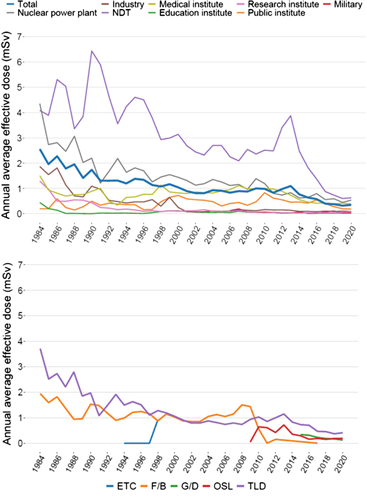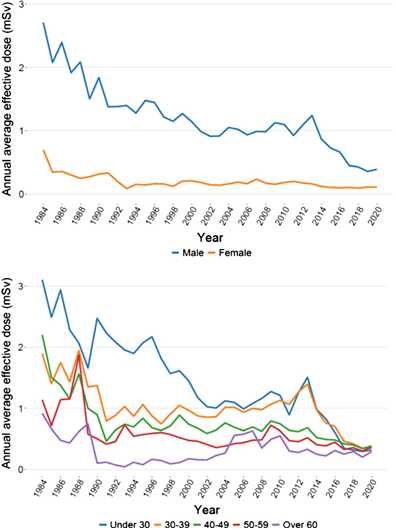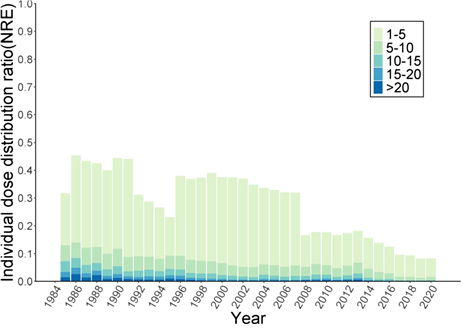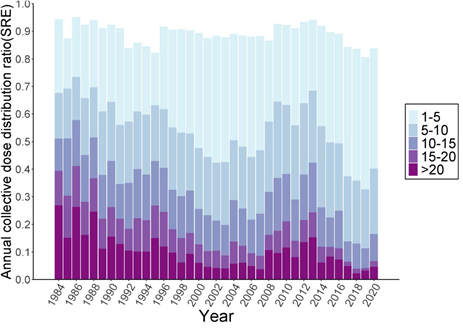글로벌 연구동향
방사선방호 및 안전
- [Health Phys .] Characteristics and Trends of Occupational Radiation Doses among Korean Radiation Workers (1984-2020)
한국 방사선 종사자의 직무상 피폭방사선량의 특성 및 경향 연구 (1984-2020)KIRAMS / 노은비, 서성원*
- 출처
- Health Phys .
- 등재일
- 2023 May 1
- 저널이슈번호
- 124(5):372-379.
- 내용
-
Abstract
This study identified characteristics of occupational radiation doses among Korean radiation workers from 1984-2020 using the National Dose Registry. The overall mean effective dose from 1984-2020 was 1.05 mSv y -1 , with the highest mean effective dose of 2.61 mSv y -1 for non-destructive testing workers. The mean effective dose gradually decreased from 2.97 mSv in 1984 to 0.34 mSv in 2020. The largest decline ratio between 1984 and 2020 was observed in educational institutions at 97.4% (0.84 mSv in 1984 and 0.02 mSv in 2020), followed by industries at 96.5% (2.55 mSv in 1984 and 0.09 mSv in 2020). Compared to 1984, the individual dose-distribution and collective dose-distribution ratios in 2020 decreased by 82.6-99% and 53.7-94.7%, respectively. This downward trend was consistent in all occupations, while decline characteristics were different depending on occupation types, work experience, and changes in radiation safety regulations. Considering that some changes in radiation doses in the registry could be solely based on changing the recording mode regardless of the actual changes in radiation doses, a careful understanding of radiation doses in the registry is particularly relevant for future epidemiological studies.

1984-2020년 간 개인 피폭선량을 업종, 선량계, 성별, 연령별 다각도로 층화하여 선량 변화를 살펴보았습니다. 전반적인 피폭선량 감소추세가 모든 특성에서 공통적으로 나타납니다.


1984-2020년 간 개인 피폭선량을 선량초과자수 분포율(NRe)과 집단선량분포율(SRe)로 살펴보았을 때, 1984년-2020년까지 점진적 감소가 이루어졌습니다. 이러한 변화양상은 특정시기에 피폭선량 관련 규제·규정 변화에 영향을 받는 모습 또한 나타납니다.
Affiliations
Eunbi Noh 1, Dalnim Lee 1, Sunhoo Park 1, Sun Dong Ju 2, Ji-Hye Kim 2, Songwon Seo 1
1National Radiation Emergency Medical Center, Korea Institute of Radiological and Medical Sciences, Seoul, Republic of Korea.
2Radiation Safety Division, Korea Foundation of Nuclear Safety, Gyeonggi-do, Republic of Korea.
- 연구소개
- 본 연구는 국내 방사선작업종사자의 피폭 방사선량 기록을 활용하여, 1984-2020년까지의 연도별·업종별 피폭선량 변화 추이를 탐색한 연구입니다. 자료원으로 한국원자력안전재단의 방사선작업종사자 방호기록 등록부에 포함된 전체 196,379명의 피폭선량을 활용하였습니다. 연간 유효선량은 1984년 2.97mSv에서 2020년 0.34mSv로 89% 감소하였으며, 이러한 경향은 미국, 유럽, 일본 등에서 보고된 종사자 유효선량 감소 경향과 유사합니다. 또한, 1984년-2020년 선량 초과자 수 분포율(NRe; the individual dose-distribution ratio)과 집단 선량 분포율(SRe; the collective dose-distribution ratio)도 모든 업종에서 시간에 따라 큰 폭으로 감소하였습니다. 이러한 종사자의 피폭유효선량 감소는 방사선 안전 강화 정책에 따른 작업기준, 보호규정, 관리체계 등의 전반적인 피폭선량 저감화 노력이 반영된 것으로 보입니다. 앞으로의 직업성 피폭 건강영향평가 시에는, 이러한 시대적·기술적 이질성을 반영하여 결과를 분석하고 해석할 필요가 있습니다.
- 덧글달기
- 이전글 [Phys Med Biol .] Strategy to implement a convolutional neural network based ideal model observer via transfer learning for multi-slice simulated breast CT images
- 다음글 [Appl Radiat Isot .] Derivation of site-specific derived concentration guideline levels at Korea Research Reactor 1 and 2 sites using probabilistic analysis










편집위원
35년 이상의 축적 데이트를 통한 직무상 피폭량에 대한 연구가 향후 종사자의 피폭평가에 활용될 수 있는 좋은 결과인 것은 사료됨.
2023-07-05 14:41:13